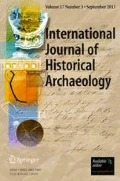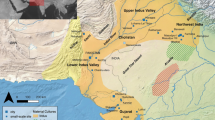Abstract
This paper analyses the walled landlord villages of the Tehran Plain in terms of hierarchy and control, and how these structures are created and expressed through the spatial landscape of the villages. Drawing on original fieldwork, the ways in which landlords used the physicality of the villages to maintain and reinforce control over farmers is explored. We suggest that the “success” or at least longevity of the land tenure system in Iran prior to the later twentieth century can be attributed at least in part to the buildings and spaces of the villages themselves.








Similar content being viewed by others
References
Bausani, A. (1962). The Persians from the Earliest Days to the Twentieth Century, Elek books, London.
Behnam, J. (1968). Population. In Fisher, W. B. (ed.), The Cambridge History of Iran. Volume I. The Land of Iran, Cambridge University Press, Cambridge, pp. 468–485.
Blake, E. (2004). Space, spatiality, and archaeology. In Meskell, L., and Preucel, R. W. (eds.), A Companion to Social Archaeology, Blackwell, Oxford, pp. 230–254.
Bourdieu, P. (1977). Outline of a Theory of Practice. (Nice, R., trans.) Cambridge University Press, Cambridge.
Casella, E. C. (2010). Landscapes of punishment and resistance: A female convict settlement in Tasmania, Australia. In Preucel, R. W., and Mrozowski, S. A. (eds.), Contemporary Archaeology in Theory: The New Pragmatism, 2nd ed, Wiley-Blackwell, Chichester, pp. 92–103.
Curzon, G. N. (1892). Persia and the Persian question, Longmans, Green, London.
Dandamaev, M. A., and Lukonin, V. G. (1989). The Culture and Social Institutions of ancient Iran, Cambridge University Press, Cambridge.
Dobres, M.-A., and Robb, J. E. (2000). Agency in archaeology: Paradigm or platitude? In Dobres, M.-A., and Robb, J. E. (eds.), Agency in Archaeology, Routledge, London, pp. 3–17.
English, P. W. (1966). City and Village in Iran: Settlement and Economy in the Kirman Basin, University of Wisconsin Press, Madison.
Fazeli, H., and Young, R. (2008). Landlord villages of the Tehran Plain, Iran: results of the first season (2007). Iran 46: 347–360.
Fazeli, H., Salami, M., and Young, R. (2009). Landlord villages of the Tehran Plain, and historical archaeology in Iran. Iran 47: 149–164.
Ferrier, J. P. (1856). (Jesse, W., trans.) Caravan Journeys and Wanderings in Persia, Afghanistan, Turkistan and Beloochistan; with Historical Notices of the Countries Lying Between Russia and India. John Murray, London.
Garthwaite, G. R. (2005). The Persians, Blackwell, Oxford.
Giddens, A. (1979). Central Problems in Social Theory. Action, Structure and Contradiction in Social Analysis, Macmillan, London.
Giddens, A. (1984). The Constitution of Society: Outline of the Theory of Structuration, Polity Press, Cambridge.
Gilchrist, R. (1994). Gender and Material Culture: The archaeology of Religious Women, Routledge, London.
Hodder, I. (2004). The “social” in archaeological theory: An historical and contemporary perspective. In Meskell, L., and Preucel, R. W. (eds.), A Companion to Social Archaeology, Blackwell, Oxford, pp. 23–42.
Hodder, I., and Hutson, S. (2003). Reading the Past: Current Approaches to Interpretation in Archaeology, 3rd ed, Cambridge University Press, Cambridge.
Hooglund, E. J. (1982). Land and Revolution in Iran, 1960-1980, University of Texas Press, Austin.
Horne, L. (1994). Village Spaces: Settlement and Society in Northeastern Iran, Smithsonian Institution Press, Washington, DC.
Johnson, M. (1996). An Archaeology of Capitalism, Blackwell, Oxford.
Kazemi, F. (1980). Poverty and Revolution in Iran: The Migrant Poor, Urban Marginality and Politics, New York University Press, New York.
Keddie, N. R. (1980). Iran: Religion, Politics and Society, Frank Cass, London.
King, A. (2005). Structure and agency. In Harrington, A. (ed.), Modern Social Theory: An Introduction, Oxford University Press, Oxford, pp. 215–232.
Lambton, A. K. S. (1953). Landlord and Peasant in Persia: A Study of Land Tenure and Land Revenue Administration, Oxford University Press, Oxford.
Loeffler, R. (1988). Islam in Practice: Religious Beliefs in a Persian Village, State University of New York Press, Albany.
McGuire, R., and Walker, M. (2008). Class. In McGuire, R. (ed.), Archaeology as Political Action, University of California Press, Berkeley, pp. 98–139.
Moore, H. L. (2000). Ethics and ontology: Why agents and agency matter. In Dobres, M.-A., and Robb, J. E. (eds.), Agency in Archaeology, Routledge, London, pp. 260–263.
Moreland, J. (2001). Archaeology and Text, Duckworth, London.
Nezam-Mafi, M. E. (1993). The Khālisah of Varamin. International Journal of Middle East Studies 25: 5–15.
Pauketat, T. R. (2000). The tragedy of the commoners. In Dobres, M. A., and Robb, J. E. (eds.), Agency in Archaeology, Routledge, London, pp. 113–129.
Preucel, R. W., and Meskell, L. (2004). Knowledges. In Meskell, L., and Preucel, R. W. (eds.), A companion to social archaeology, Blackwell, Oxford, pp. 3–22.
Rowlands, M. (1989). A question of complexity. In Miller, D., Rowlands, M., and Tilley, C. (eds.), Domination and Resistance, Routledge, London, pp. 29–40.
Savory, R. (1978). Social development in Iran during the Pahlavi era. In Lenczowski, G. (ed.), Iran Under the Pahlavis, Hoover Institution Press, Palo Alto, pp. 85–127.
Schimmel, A. (1992). Islam: An Introduction, State University of New York Press, Albany.
Wallace, R. A., and Wolf, A. (2006). Contemporary Sociological Theory: Expanding the Classical Tradition, Pearson, Prentice Hall, Englewood Cliffs.
Weber, M. (1968). On Charisma and Institution Building: Selected Papers, University of Chicago Press, Chicago.
Acknowledgments
This project has been funded by the British Institute of Persian Studies. The authors would like to thank the following institutions and individuals: Iran Centre for Archaeological Research; University of Tehran; University of Leicester; Azad University, Varamin-Pishva; Iran National Museum; National Centre for Handicrafts and Heritage, Iran; American University of Beirut. Mr. Pooria Saeedi (draughtsman), Ms. Hengameh Ilkani (ethnographer and translator), Ms. Minoo Salimi (ethnographer and archaeologist), Ms. Maryam Naimi (ethnographer, translator and archaeologist), Ms. Nastaran Moradi, Mr. Amir Arab, Mr. Abolfazl Moheban, Mr. Hassan Asghari, Mr. Sajjad Arabsharab, Mr. Mohammad Sadeghi, (all archaeologists); Mr. Suleymanye (driver), Mr. Ali Abargarhoui, Mr. Haj Ahmed Akbari, Mr. Haj Abolgasm Ghodsi, Mr. Hassan Hosseini, Mr. Khale Khoui, Mr. Haj Akbar Mahabadi, Mrs. Kouchak, Ms. Jamileh Emem Ghouli and the Kazempour family, Mr. Mohummad Hossein Mohseni, Mr. Hassan Rahimi, Mr. Mohsen Arab Salmani, Mr. Abas Ramazon Zadeh, Mr. Haj Mahmoudh Zaraei, Mr. Faraj Uriyat, Mr. Aziz Uriyat, Mr. Mahmod Sahriai, Mrs. Zahra Jamali, and Mr. Jafari; Graeme Barker, University of Cambridge; Robin Coningham, Durham University; Audrey Horning, Queen’s University Belfast; Timothy Insoll, University of Manchester; Paul Newson, American University of Beirut; Ian Reeds, University of Leicester. We are also very grateful to the Centre for Historical Archaeology in the School of Archaeology and Ancient History, University of Leicester and the inspiration and help provided by members.
Author information
Authors and Affiliations
Corresponding authors
Rights and permissions
About this article
Cite this article
Nashli, H.F., Young, R. Landlord Villages of Iran as Landscapes of Hierarchy and Control. Int J Histor Archaeol 17, 143–158 (2013). https://doi.org/10.1007/s10761-012-0213-y
Published:
Issue Date:
DOI: https://doi.org/10.1007/s10761-012-0213-y




